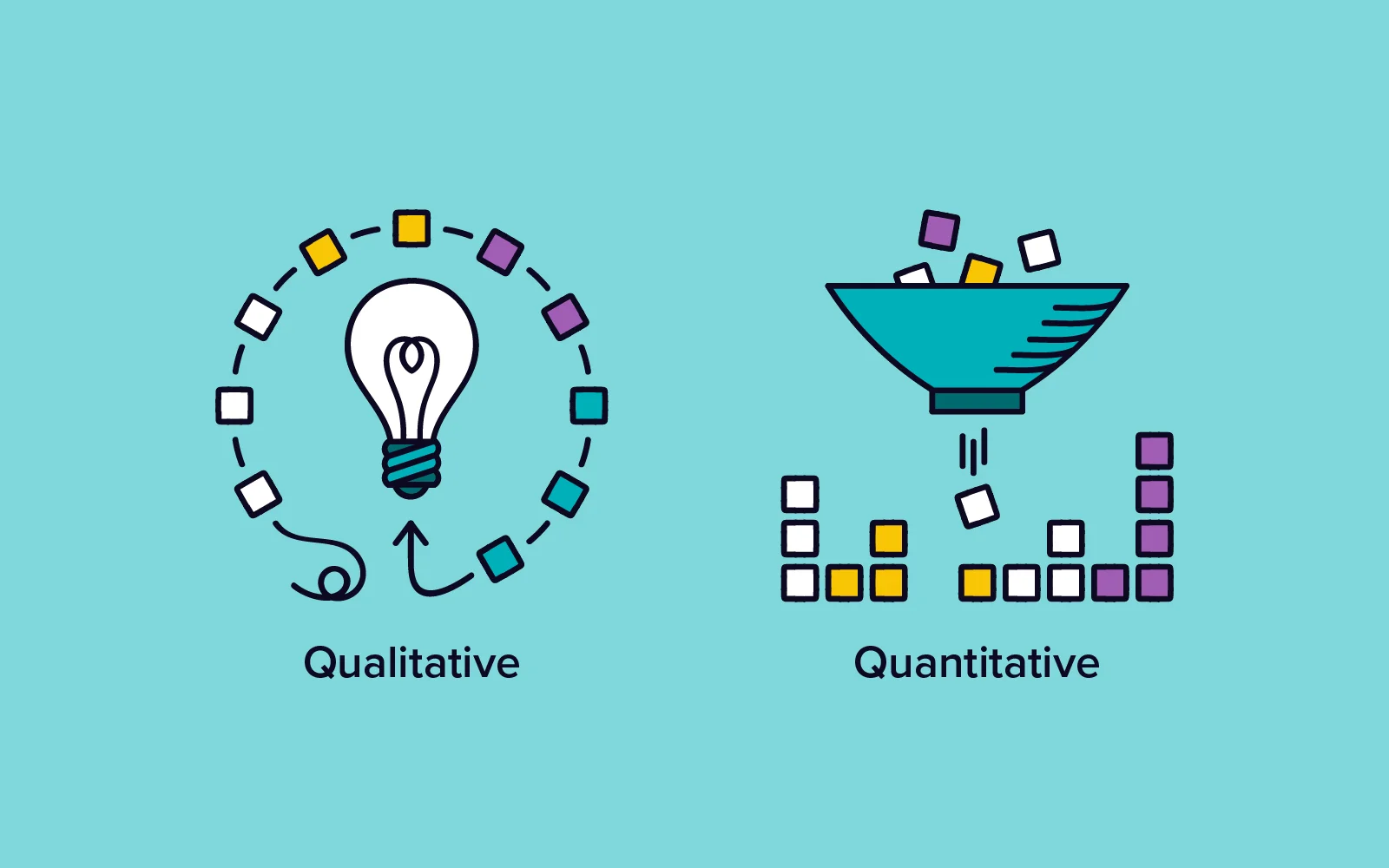Hello!
Research is simply the investigation of existing facts, theories, or assumptions to create knowledge. quantitative vs qualitative research may be conducted to generate new methodologies, concepts, and understanding. And several techniques may be employed to achieve this.
 Research is usually defined by the methodology used in investigating and interpreting facts. There are two main types of research techniques. They include quantitative vs qualitative research. You have probably heard the same thing in class.
Research is usually defined by the methodology used in investigating and interpreting facts. There are two main types of research techniques. They include quantitative vs qualitative research. You have probably heard the same thing in class.
But why does it seem impossible to understand how both of these research techniques work? The answer is simply because you are yet to understand the difference between them.
In this article, we are going to be discussing the difference between quantitative vs qualitative research.
Let’s Demystify Qualitative Vs Quantitative
 Before we explain the difference between qualitative vs quantitative research, it is essential to understand what it means for something to be quantitative or qualitative.
Before we explain the difference between qualitative vs quantitative research, it is essential to understand what it means for something to be quantitative or qualitative.
A thing is qualitative when it focuses on a property, attribute, and a level of excellence, instead of numbers. Qualitative deals with a phenomenon that can be observed more than a phenomenon that can be measured.
A thing is quantitative when it focuses on the use, application, and implications of numbers. Quantitative necessarily involves the analysis of the relationship between a group of numbers. And a conclusion is usually inferred from the analysis.
You can identify which research technique to use by understanding the primary focus of the study.
What is Quantitative VS Qualitative Research
 quantitative vs qualitative research deals with investigation, interpretation, and conclusion. Qualitative research involves the gathering and interpretation of non-numerical data to capture opinion and interest.
quantitative vs qualitative research deals with investigation, interpretation, and conclusion. Qualitative research involves the gathering and interpretation of non-numerical data to capture opinion and interest.
This research approach seeks to answer how and why a particular phenomenon functions the way it is.
Qualitative research data includes non-numerical materials in the form of text, audio files, and videos. This research technique is preferred to quantitative research where an in-depth understanding of a problem is necessary.
Qualitative research is used in the humanities and social sciences. Fields like Philosophy, Anthropology, Education, History, etc, favors qualitative research over quantitative research.
Advantages of Quantitative Over Qualitative Research
 You may opt for qualitative research over quantitative research due to the following reasons:
You may opt for qualitative research over quantitative research due to the following reasons:
- Unlike quantitative research, you can easily modify the purpose and method of analysis in qualitative research.
- Qualitative research provides a better platform for researchers to explore a research topic.
- Research is done in a natural setting
- Qualitative research can capture changes in attitudes and patterns of a study group better than quantitative research.
- Qualitative research is naturally suited for the in-depth study of a phenomenon.
Disadvantages of Quantitative vs Qualitative Research
Despite the good points, qualitative research has got its fair share of disadvantages over quantitative research.
 They include the following:
They include the following:
- Qualitative research is usually limited by the size of the research subject
- It is difficult to generalize research results
- Personal bias may affect qualitative research result
- Qualitative research can be stressful as data analysis are usually done manually
On the other hand, quantitative research involves the collection and analysis of numerical data. This research is often used to test the causal relationship between variables.
For example, quantitative research may study the percentage increase in cocoa production caused by an increase in the use of machines in Africa between 2007-2020.
This type of research may involve tables, graphs, and charts to represent relationships between numbers and a particular period. Qualitative research data are used to show averages, patterns, and make predictions.
Quantitative research data are usually gotten from experiments, controlled observations, and questionnaires.
Advantages of Quantitative vs Qualitative Research
 Some of the advantages of quantitative research over qualitative research include the following:
Some of the advantages of quantitative research over qualitative research include the following:
- Research results are usually more reliable if the research is tailored towards objectivity.
- The use of analytical tools makes quantitative research less strenuous than qualitative research
- Qualitative research can be replicated anywhere in the world
- Research design eliminates researchers personal bias
- Research results can serve as benchmarks for generalizations
Disadvantages of Quantitative Over Qualitative Research
Quantitative research also has lots of disadvantages over qualitative research.
 Some of them are:
Some of them are:
- Qualitative research does not take place in a natural setting
- Data quantity may affect the generalizability of research result
- Expertise may affect the credibility of results
- Inability to give up a theory or hypothesis may affect the objectivity of research
When To Use Qualitative Vs Quantitative Research
 As a researcher, it is salient that you can identify when to use qualitative or quantitative methods in research. A common way to do this is by defining the purpose of the research.
As a researcher, it is salient that you can identify when to use qualitative or quantitative methods in research. A common way to do this is by defining the purpose of the research.
Is the purpose to test or confirm something. If yes, then quantitative research is what you need. If the purpose of the research is to better understand a concept or a theory, qualitative research works fine.
Quantitative research is naturally suited for inductive research, while qualitative research is suited for deductive research. Quantitative research also favors experimental studies more than correlations and descriptive studies.
By defining the research purpose, method, and type, you can know whether to use quantitative vs qualitative methods.
Qualitative Vs Quantitative Data
 In this section, we are going to be discussing what is research data and how it works in qualitative and quantitative research. Research data is simply any information that has been collected to validate or arrive at a research conclusion.
In this section, we are going to be discussing what is research data and how it works in qualitative and quantitative research. Research data is simply any information that has been collected to validate or arrive at a research conclusion.
Generally, your research data is determined by the research approach you are using. Qualitative Vs quantitative data simply tells you the type of data that is used for each of these types of research.
#1. What is Qualitative Data?
 Qualitative data is any non-numerical information, and characterized by properties and attributes relevant to the study of a phenomenon.
Qualitative data is any non-numerical information, and characterized by properties and attributes relevant to the study of a phenomenon.
The information can be derived from observing the phenomenon in its natural phenomenon. It may also be derived from a recorded video of the phenomenon in question. Qualitative data can be text, a photograph, an audio file, or a video.
Method of Collecting Qualitative Data
Qualitative data can be collected using either of the following-
- One-on-one interview
- Observation
- Case studies
- Study Review
A. One-on-One Interview
This involves a one-on-one question and answers session.
Research data from interviews can be gotten by following these three essential steps:
- Choose relevant interviewee
- Design interview questions
- Proceed with the interview
Generally, research interviews may be formal or informal depending on the research topic and the interviewee’s personality. The research may also require a recorder to ensure responses are captured accurately.
B. Observation
 Observation is important when we talk about qualitative Vs quantitative research data. This is used in both research approaches, and the only difference is how it is used. A qualitative researcher observes and records relevant information.
Observation is important when we talk about qualitative Vs quantitative research data. This is used in both research approaches, and the only difference is how it is used. A qualitative researcher observes and records relevant information.
C. Case Study
Qualitative research data can be gathered through an in-depth study of a particular group or phenomenon.
Case studies usually involve one or more methods of data collection. For instance, the researcher may combine observation, and documentaries to make inferences.
D. Study Review
This involves the study of existing reports and documents on the research subject. It is the use of existing information to run your research. Researchers may have to review what others have said on the subject.
#2. What is Quantitative Data
Quantitative data is simply any information expressing a certain amount, quantity, or range.
Method of Collecting Quantitative Data
 There are three main methods for collecting quantitative data, which include:
There are three main methods for collecting quantitative data, which include:
- Experiment
- Observation
- Survey
A. Experiment
Quantitative data may be derived from manipulating variables to establish cause and effect relationships. This may be done on a large scale, or even for a small number of variables.
B. Observation
This involves a close study of a subject in their natural environment. Observation is used where variables can not be controlled such as in a natural environment. The researcher may be required to visit the subject’s natural environment.
Are Surveys Qualitative or Quantitative?
 Generally, surveys are used in most quantitative research. However, surveys have also been used in qualitative researches. Researchers use surveys to gather information from a selected sample of people.
Generally, surveys are used in most quantitative research. However, surveys have also been used in qualitative researches. Researchers use surveys to gather information from a selected sample of people.
Quantitative surveys are also used to test hypotheses by collecting and numbers from data. While qualitative surveys collect data to describe a topic. A survey is not necessary for most qualitative research.
Qualitative and Quantitative Data Examples
Qualitative data is different from quantitative data. Examples of qualitative data include sex, name, state of origin, color, etc. While examples of quantitative data include the number of people living in Africa in 2021, the number of students that wrote a particular test, etc.
Qualitative Vs Qualitative Analysis
Analysis in quantitative vs qualitative research involves some steps. In qualitative analysis, the researcher must decide whether the research will use the deductive or inductive approach.
 Deductive analysis occurs when a researcher uses a predetermined structure to analyze data. This often happens when the researcher has an idea of the responses he or she will receive from a sample population.
Deductive analysis occurs when a researcher uses a predetermined structure to analyze data. This often happens when the researcher has an idea of the responses he or she will receive from a sample population.
While inductive analysis is used where the researcher does not know what he or she expects from the sample population. There are four simple steps to follow when you are doing qualitative analysis.
They include:
- Collect and organize data
- Set a code to the data collected
- Ensure nothing is missing
- Conduct the analysis
The above method is different from quantitative analysis. In quantitative analysis, the researcher makes use of mathematical or statistical models to interpret data.
Some common techniques for quantitative analysis include:.
- Regression analysis: used for estimating the relationship between a dependent variable and one or more independent variables.
- Linear programming: used to ensure that optimal performance is guaranteed by a research result
- Data mining: used to evaluate very large data to identify patterns and correlations within them.
 Quantitative analysis should reveal the following information:
Quantitative analysis should reveal the following information:
- Trends, and causal relationships
- Implications of data results
- Limitation of result where possible
Conclusion
We have come to the end of our discussion on qualitative vs quantitative research. In this article, we have been able to explain most of the differences between qualitative vs quantitative research.
 We believe you can identify each and apply each of them where necessary. All you have to do is to read our guide anytime you are confused about them.
We believe you can identify each and apply each of them where necessary. All you have to do is to read our guide anytime you are confused about them.
FAQ
1. What does qualitative mean?
2. What is quantitative and qualitative research?
3. Is quantitative better than qualitative?
4. What are examples of quantitative data?
5. What are examples of qualitative data?
6. What are the similarities between quantitative and qualitative?
Also read:
- SEO for Architects
- DTC Marketing 101: A Guide to Direct-to-Consumer Marketing Strategies
- QUASA x KickEX = QUA Airdrop
Thank you!
Subscribe to our newsletter! Join us on social networks!
See you!






